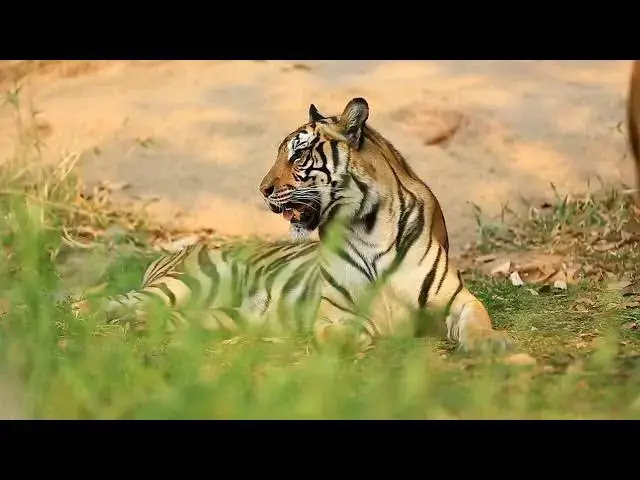Explore the factors that influence tiger prey selection, including prey size, availability, energy expenditure, and vulnerability. Learn how these apex predators make strategic hunting choices to survive in their habitats.
Show More Show Less View Video Transcript
0:00
how Tigers choose their prey a look at
0:03
hunting
0:04
decision Tigers The Majestic apex
0:08
predators of Asia are renowned for their
0:10
strength and hunting
0:13
prowess have you ever wondered how these
0:15
striped Hunters choose their next meal
0:18
when faced with multiple
0:20
options today we will explore the
0:23
fascinating world of tiger prey
0:25
selection and uncover the factors that
0:28
influence their hunting decisions
0:31
when it comes to selecting prey tigers
0:33
are not simply opportunistic Hunters
0:36
that pounce on the first animal they
0:38
see instead they employ a complex
0:42
decision-making process that takes into
0:44
account various factors to ensure they
0:46
make the most efficient and rewarding
0:49
Choice one of the primary considerations
0:52
for Tigers When selecting prey is the
0:56
size of the potential
0:58
Target Tigers generally prefer medium to
1:01
large-sized ulates such as deer wild
1:05
boar and even smaller species of
1:08
cattle these animals provide a
1:10
substantial amount of meat which is
1:13
crucial for sustaining the Tiger's
1:15
energy
1:16
needs however the size preference can
1:19
vary depending on the Tiger's own size
1:22
age and physical
1:25
condition availability of prey species
1:27
in the tiger's habitat also plays a
1:30
significant role in their selection
1:33
process tigers are adaptable predators
1:38
and will adjust their preferences based
1:41
on the abundance of different prey
1:43
species in their
1:45
territory in areas where their preferred
1:48
prey is scarce Tigers May opt for
1:51
smaller or less common animals to meet
1:54
their nutritional
1:55
requirements energy expenditure is
1:58
another critical factor in a tiger's
2:01
prey
2:03
selection these big cats must carefully
2:06
balance the energy they spend hunting
2:08
with the energy they gain from their
2:11
catch as a result Tigers often assess
2:14
the difficulty of the hunt and potential
2:16
risks involved before committing to a
2:19
particular prey they may choose to
2:22
pursue an animal that requires less
2:25
energy to catch even if it is not their
2:28
most preferred option
2:30
research has shown that Tigers also
2:32
consider the behavior and vulnerability
2:35
of potential
2:36
prey animals that are sick injured or
2:40
separated from their herd are often
2:42
targeted as they present an easier
2:44
opportunity for a successful hunt this
2:48
strategy not only conserves energy but
2:51
also reduces the risk of injury to the
2:53
tiger during the hunt interestingly
2:56
Studies have revealed that tigers can be
2:59
quite selective in their hunting
3:01
patterns in some cases individual tigers
3:05
have been observed to specialize in
3:07
hunting certain prey species developing
3:10
specific techniques and strategies to
3:12
increase their success rate this
3:16
specialization can be influenced by
3:18
factors such as the tiger's habitat
3:20
physical capabilities and learned
3:24
behaviors the time of day and season can
3:26
also affect a tiger's prey selection
3:30
some prey species may be more active or
3:33
vulnerable During certain hours or
3:34
seasons and tigers often adjust their
3:37
hunting patterns
3:39
accordingly for example they may Target
3:42
prey that frequents water sources during
3:44
dry seasons when animals are more likely
3:47
to gather around limited water
3:49
bodies understanding how Tigers select
3:52
their prey is not just a matter of
3:54
scientific
3:56
curiosity this knowledge is crucial for
3:59
conservation efforts aimed at protecting
4:02
these magnificent
4:04
creatures by comprehending the factors
4:07
that influence tiger hunting Behavior
4:10
conservationists can better manage tiger
4:13
habitats and ensure the availability of
4:16
suitable prey
4:17
species this in turn helps reduce human
4:22
tiger conflicts and supports the
4:24
long-term survival of tiger populations
4:27
in the wild it in conclusion tiger prey
4:31
selection is a complex process
4:34
influenced by factors such as prey size
4:37
availability energy expenditure and
4:41
vulnerability by making informed
4:44
decisions about their targets Tigers
4:47
demonstrate their remarkable
4:48
adaptability and intelligence as
4:52
Predators as we continue to study and
4:56
understand these incredible animals we
4:58
gain valuable insight that can help us
5:00
protect them and maintain the delicate
5:03
balance of ecosystems they inhabit
#Pets & Animals
#Wildlife
#Biological Sciences
#Ecology & Environment
#Hunting & Shooting

